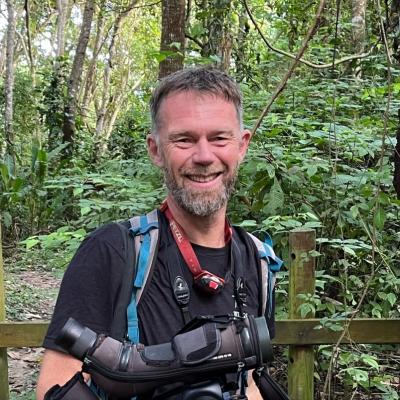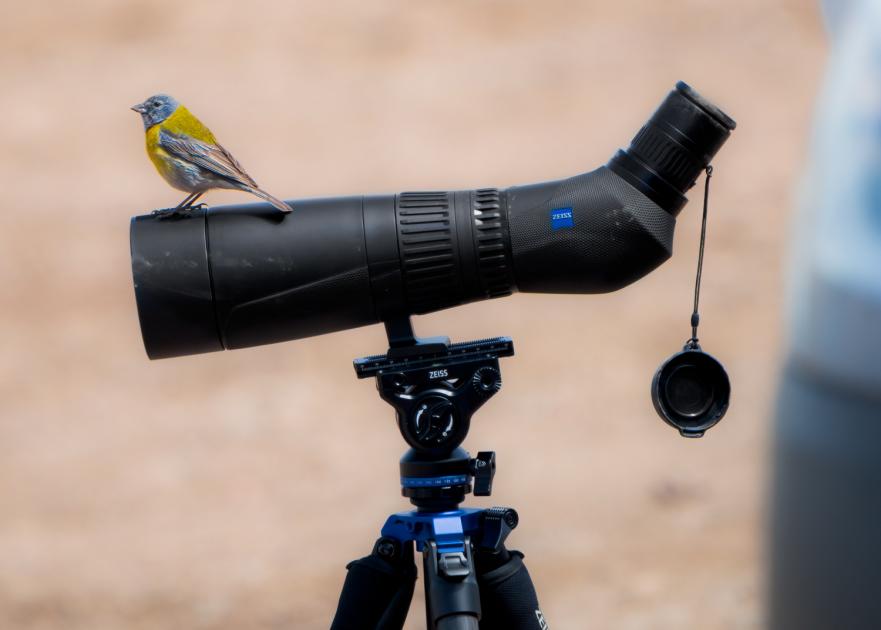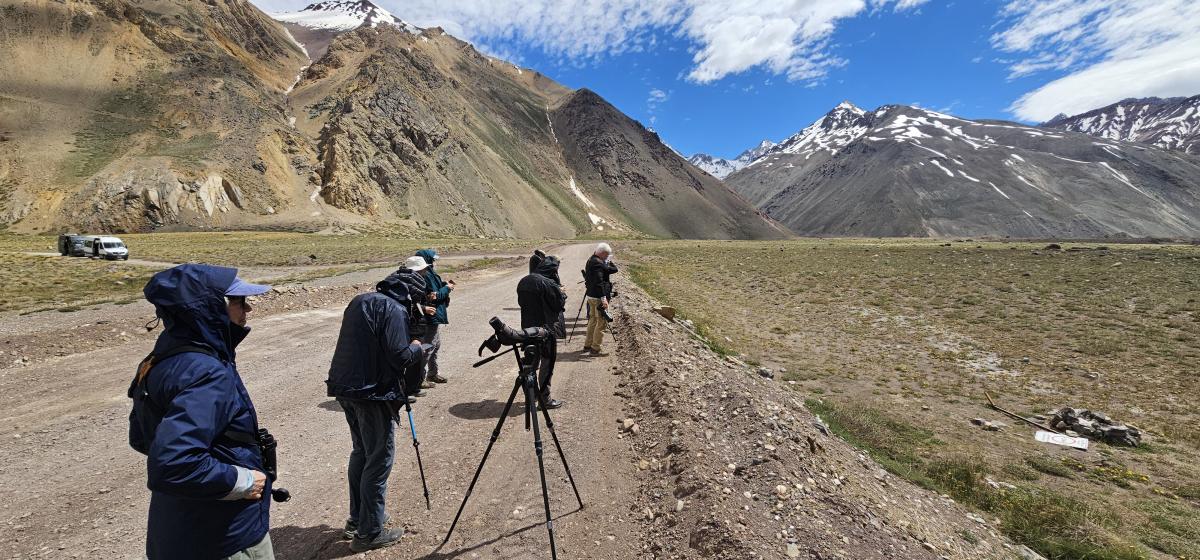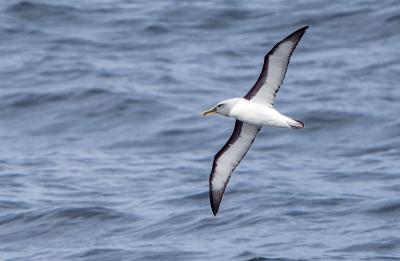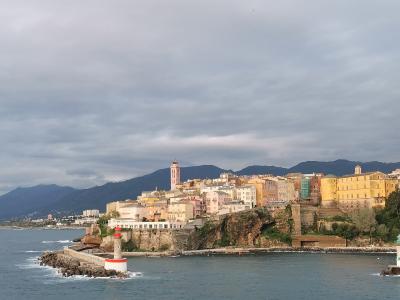Chile: Tierra del Fuego to the Atacama Desert
-
Nov 3-19, 2026
Fabrice Schmitt and J Quillén Vidoz
-
Nov 3-19, 2027
Stephen Menzie and J Quillén Vidoz
2027
2027 Tour Price to be Determined
2027
2027 Tour Price to be Determined
A fascinating collection of birds coupled with some of the most spectacular scenery on earth makes birding in Chile a superb experience. This narrow strip of territory, 150 miles wide by 2,500 miles long, is a land of immense variety and beauty: from the grandeur of wave-dashed Pacific beaches to the solitude of high Andean lakes, and from the rolling plains of Tierra del Fuego to the utterly barren Atacama, the most perfect of deserts. Traveling the length (and breadth) of the country impresses upon one the remarkable similarities of climate, vegetation and topography, not to mention convergent evolution, between the Northern and Southern Hemispheres. Our tour of Chile is the equivalent of going from southeastern Alaska to southwestern Mexico! Birders today can thank Goodall, Johnson, Millie, and Philippi, who brought to the fore our knowledge of Chile’s avifauna through their extensive field work from the 1920s through the 1950s. The triumphs and failures of this pioneering work are conveyed in Johnson’s classic Birds of Chile, now sadly out of print. Their work showed that Chile has a bird list combining high quality and high visibility. The avifauna ranges from penguins, rheas, flamingoes and a superb selection of southern waterfowl and shorebirds to 30 species of ovenbirds (furnariids), eight tapaculos (three of them endemic), nine sierra-finches, and five siskins.
Our tour coincides with the austral spring, when bird activity is at its height, and is designed to take in all the major regions of this diverse land. Chile is throughout a safe and friendly country in which to travel, and has an excellent infrastructure for tourism.
Day 1: The tour begins at 12 noon in the lobby of our Santiago hotel. If flight arrival times allow, we’ll visit some nearby areas for an introduction to the birdlife of Chile’s Central Valley. Night in Santiago.
Day 2: This morning we’ll take the spectacular flight south to Punta Arenas on the northern shores of the Straits of Magellan. The bleak, gray stone buildings of Punta Arenas belie its people, mainly of eastern European descent, who are as warm and hospitable as one finds anywhere, while the rocky coast and rolling grasslands, with their enclaves of European sheep farmers, suggest northern Scotland. Ancient forests of twisted, stunted Nothofagus (southern beech) trees reflect the harshness of the southern temperate climate and contribute to the distinctive flavor of Patagonia, a world apart from the rest of South America. Birding in the vicinity after our arrival will produce a taste of the wealth of waterbirds for which the area is famous, including Imperial and Magellanic Cormorants, Upland Goose, Flying Steamer-Duck, Two-banded Plover, Chilean Skua, and Dolphin Gull plus the tiny and endearing Austral Negrito and the ubiquitous Rufous-collared Sparrow. Night in Punta Arenas.
Days 3-4: We’ll have two full days to explore the vast, windswept Magellanic region. One day we’ll take the short ferry ride across to Tierra del Fuego, where we should see Magellanic Diving-Petrel, Magellanic Penguin, Southern Giant-Petrel, and perhaps the beautiful Commerson’s Dolphin. One of our main goals on Tierra del Fuego will be to find the enigmatic and dove-like Magellanic Plover (placed in its own family, Pluvianellidae), nesting at this season amid migrant Baird’s and White-rumped Sandpipers. Other breeding shorebirds include the handsome Tawny-throated and Rufous-chested Dotterels. The numerous lakes of southernmost Chile are often alive with waterfowl such as Black-necked Swan, Ashy-headed and Ruddy-headed Geese, Crested Duck, and Yellow-billed Teal. Darwin’s (Lesser) Rheas dot the landscape in many areas, and we’ll plan to visit a small but growing colony of King Penguins. Landbirds include Short-billed and Common Miners, Patagonian Yellow-Finch, and with luck the little-known Austral Canastero and the striking Chocolate-vented Tyrant. Nights in Cerro Sombrero and Punta Arenas.
Days 5-6: This morning we’ll fly north from Punta Arenas to Puerto Montt, gateway to Chile’s picturesque Lake District. After check-in and lunch at our hotel in Puerto Montt, we will visit a nearby sanctuary protecting a patch of spectacular old-growth temperate rainforest. The huge trees are in stark contrast to the open wilderness of Patagonia, and the forests ring with the calls of two striking tapaculos, the Chucao Tapaculo and the Black-throated Huet-huet. The following day we’ll visit beautiful Chiloé Island. During the ferry ride across Chacao Channel to the island, we’ll have a chance for Magellanic Penguin and Red-legged Cormorant. Pods of Dusky Dolphins will sometimes ride the bow of the ferry. Once on Chiloé, we will visit Caullin Bay, an important wintering area for Hudsonian Godwit. In addition to these boreal migrants, we can also find a great variety of local species including Flightless Steamer-Duck, Black-necked Swan, Yellow-billed Pintail and the rare Snowy-crowned Tern. In the nearby scrub we may also spot a flock of the endemic Slender-billed Parakeet. Nights in Puerto Montt.
Day 7: For our last morning around Puerto Montt, we’ll spend most of our time birding some forested area, seeking in particular the impressive Magellanic Woodpecker and the skulking Ochre-flanked and Magellanic Tapaculos. The supporting cast here includes Austral Parakeet, Des Murs’s Wiretail, White-throated Treerunner, and Black-chinned Siskin. After a morning birding, we’ll fly north to Santiago. Night in Santiago.
Day 8: Central Chile, at the same latitude as southern and central California, has a Mediterranean climate and chaparral-like vegetation known as matorral. Extensive vineyards and the introduced California Quail, California poppy, and towering eucalyptus trees cultivate the illusion that one is in the Northern Hemisphere. To dispel any doubts we’ll spend the day birding our way to the coast at Valparaiso, passing through a variety of habitats where birds include Spot-flanked Gallinule, Wren-like Rushbird, and Rufous-tailed Plantcutter. We’ll make a special effort to see the handsome Many-colored Rush-Tyrant and the endemic White-throated Tapaculo. Along the coast we should see Peruvian Booby, Peruvian Pelican, and the beautiful Inca Tern. Night in Viña del Mar.
Day 9: Today we’ll make an early departure by boat a short distance offshore into the famous Humboldt Current which, by upwelling like its northern counterpart the California Current, provides a nutrient-rich base that supports a vast seabird population. Up to seven species of albatross are possible including Salvin’s, Buller’s, and Northern Royal, while Pintado (Cape), De Filippi’s (Masatierra) and Westland Petrels, Peruvian Diving-Petrel, and others are regularly seen. To bring us back to earth, we’ll spend the afternoon birding along the coast near our hotel. Night in Viña del Mar.
Day 10: We’ll make a morning birding trip north along the coast, including a visit to view a colony of Humboldt Penguins on an inshore islet. Species we’ll be looking for in the matorral-covered valleys leading down to the coast along our drive include Giant Hummingbird, Great Shrike-Tyrant, and the endemic Dusky-tailed Canastero and Dusky Tapaculo before our afternoon drive back to Santiago. Night in Santiago.
Days 11-12: The magnificent High Andes, their snow-capped peaks dominating the eastern horizon, are only a short drive from Santiago and will be our venue for the next two days. We’ll visit two sites with slightly different avifaunas, both in spectacular rugged settings. The birdlife of this region includes the flashy White-sided Hillstar, Gray-breasted Seedsnipe, numerous ground-tyrants, sierra-finches, and ovenbirds (including the endemic Crag Chilia), the comical Moustached Turca (a roadside tapaculo!), huge Andean Condors, and with luck the ultimate shorebird – Diademed Sandpiper-Plover. Nights in Santiago.
Day 13: A morning flight will take us north, leaving the cultivated Central Valley and heading over the bleak expanses of the Atacama Desert to the coastal town of Arica in the extreme north of Chile. Most of the day will be spent on the leisurely drive from Arica through the oasis-like Lluta Valley up to Putre, a small town nestled in a relatively lush valley at about 11,500 feet. As we climb, birds range from Croaking Ground-Dove and Peruvian Meadowlark in the lowland oases, through Greenish Yellow-Finch and Straight-billed Earthcreeper in the arid, scrubby foothills, to Andean Hillstar and Band-tailed Seedeater, both nesting near our hotel. Night in Putre.
Day 14: We’ll spend the whole day in and around Putre, taking our time with the almost completely new avifauna and also acclimating to the new elevation. We’ll see that the characteristic European face of central and southern Chile is gone. The terraced alfalfa fields and herds of llamas and alpacas, tended by Indians clad in brightly-colored wool garments, reflect the close cultural ties between northern Chile and the high Andes of Peru and Bolivia. Birds we can expect to see around Putre include Bare-faced Ground-Dove, White-throated Earthcreeper, Yellow-billed Tit-Tyrant, White-browed Chat-Tyrant, Black-throated Flowerpiercer, and Blue-and-yellow Tanager, and there’s a chance for Ornate Tinamou and Golden-billed Saltator. Night in Putre.
Day 15: Today will arguably be the highlight of the tour. We’ll spend most of the day visiting Lauca, often acknowledged as the most impressive national park in the Americas. There are no adequate descriptions for the breathtaking (literally!) scenery of the puna plains and bogs below snow-capped volcanoes. The park includes Lake Chungara, at 15,000 feet the highest lake in the world and covered with thousands of birds, among them Silvery Grebe, Puna Teal and Giant Coot. Other birds here include Andean and James’s Flamingos, Puna Plover, Andean Flicker, White-winged Cinclodes, Glacier Finch, Black Siskin, and White-throated Sierra-Finch. Common mammals in the park include the elegant Vicuña and the sleepy Vizcacha, which looks like a cross between a hare, a squirrel, and a kangaroo! After lunch we’ll leave the rarified air of the park and head back down to the oxygen-rich lowlands of Arica. Night in Arica.
Day 16: We’ll have a full day to spend birding in the lowland valleys and along the coast of northernmost Chile. We’ll especially look for the highly endangered Chilean Woodstar, a tiny hummingbird being steadily exterminated by intensive agriculture. Other species we’ll seek today include Peruvian (White-crested) Elaenia, Oasis Hummingbird, the bizarre Peruvian Thick-knee, Slender-billed Finch, and the very local Rufescent Flycatcher, and there’s always the chance for Peruvian Martin or an unexpected vagrant. The Lluta estuary usually attracts large numbers of migrant and resident waterbirds, including possibly thousands of Elegant Terns and Franklin’s Gulls, as well as Belcher’s and Gray Gulls, American Golden and Semipalmated Plovers, Little Blue Heron and many more. Night in Arica.
Day 17: If our flight to Santiago is early, we will make every effort to arrange a plan for birding and lunch in the middle of the day, although we probably won’t see any new species. The tour concludes in Santiago with plenty of time to connect with evening international flights to the US.
Note: The information presented here is an abbreviated version of our formal General Information for Tours to Chile. Its purpose is solely to give readers a sense of what might be involved if they take this tour. Although we do our best to make sure that what follows is completely accurate, it should not be used as a replacement for the formal document sent to all tour registrants, whose contents supersedes any information contained here.
ENTERING CHILE: A passport valid past the date of your departure from Chile and at least one blank passport page are required. A visa is not required of U.S. citizens.
Citizens of other countries may need a visa, and should check with the Chilean embassy or consulate. If required by the embassy or visa-granting entity, WINGS can provide a letter for you to use regarding your participation in the tour.
Citizens of the USA, UK and Canada do not have to pay the USD $160 entry (“reciprocity”) fee. As far as we are aware Australian citizens must still pay this fee (roughly USD $60); a receipt will be stapled into the passport and is good for 90 days, so don’t throw it away. These fees may change annually and can be paid in cash (but be warned you need pristine bills) or credit card.
COUNTRY INFORMATION: You can review the U.S. Department of State Country Specific Travel Information here: https://travel.state.gov/content/travel.html. Review foreign travel advice from the UK government here: https://www.gov.uk/foreign-travel-advice and travel advice and advisories from the Government of Canada here: https://travel.gc.ca/travelling/advisories.
PACE OF THE TOUR: Most days we’ll have continental breakfast between 6:00 and 7:00 a.m. (earlier before our pelagic or possible very early flights). After breakfast we usually depart for a day of birding and/or travel, with box lunches and a supply of snacks (fruit, cookies, nuts, etc.) and drinks to keep us going. One morning we do a six- to eight-hour pelagic out into the Humboldt Current. Dinners are at our hotels, and sometimes involve set menus.
Most of the walking is on level to gently sloping terrain, and there are no long hikes; particularly in the South, we do a lot of birding from in or near the vehicle. We may descend a couple of short steep slopes to important birding areas; on one day we may walk around on a (dry) bog at 14,000 feet elevation, but in such cases there is the option to stay in the vehicle.
With an increasingly warm climate, wet areas we used to wade in for some birds have been mostly dry for several years, and there seems no longer a need to bring rubber boots; however, if things change there may be a chance of wet feet at one site where we seek Diademed Sandpiper-Plover, although any water there is usually shallow and regular boots (or sandals!) have sufficed in recent years.
We make an effort to stop for restroom breaks wherever possible. However, at some birding locations, we’ll be away from facilities for several hours and it may be necessary to take a “comfort stop” in nature.
HEALTH: There are no major health risks in Chile. The Centers for Disease Control and Prevention (CDC) recommends that all travelers be up to date on routine vaccinations. These include measles-mumps-rubella (MMR) vaccine, diphtheria-tetanus-pertussis vaccine, varicella (chickenpox) vaccine, polio vaccine, and your yearly flu shot.
They further recommend that most travelers have protection against Hepatitis A and Typhoid.
Please contact your doctor well in advance of your tour’s departure as some medications must be initiated weeks before the period of possible exposure.
The most current information about travelers’ health recommendations can be found on the CDC’s Travel Health website at http://wwwnc.cdc.gov/travel/destinations/traveler/none/chile .
Since it may be impossible to obtain personal medications, please bring what you will need.
Water: Water supplies are excellent, but bottled water is also widely available. Immodium or Pepto Bismol in tablet form can be recommended as the best treatment for occasional traveler’s diarrhea.
Insects: We may occasionally encounter mosquitoes or biting gnats; we recommend using insect repellents with a high concentration of DEET.
Altitude: In the South and the Lake District we won’t be at elevations higher than about 5,000 feet, but in the Andes of Central Chile we get up to 10,000 feet. In the north, we’ll get to 15,000 feet for one day, but it is possible to stay at the hotel at 11,500 feet, near which we’ll spend the preceding day to help acclimate. We do not run around at these elevations, and much of the birding is from the vehicles. People with a history of respiratory or coronary problems should consult with their doctors in any event.
Motion Sickness: We will have one or possibly two boat trips.
Smoking: Smoking is prohibited in the vehicles or when the group is gathered for meals, checklists, etc. If you are sharing a room with a nonsmoker, please do not smoke in the room. If you smoke in the field, do so well away and downwind from the group. If any location where the group is gathered has a stricter policy than the WINGS policy, that stricter policy will prevail.
CLIMATE: The Austral spring means that weather in the South and Lake District can vary from bright and sunny (though not warm) to cold and rainy, or even snowy; and it tends to be windy and cool in the South (below freezing with the wind chill).
In Central Chile it is similar to spring in central California, i.e., from sunny and mild (60s to 70s) in the lowlands to cool (and in the afternoons windy) at high elevations (50s or even 40s early and late in the day). The coast can be sunny and breezy or cool and foggy, just like California.
The Atacama Desert in the North is the driest place on Earth, and rain at this season would be exceptional; the lowlands are hot (to cool and foggy on the coast; 50s to high 70s), the highlands cold at night (at times dropping to freezing, though this is less common as the climate warms) and in the early morning, becoming sunny and warm (70s or higher) in mid-morning, and usually windy in the afternoons.
ACCOMMODATIONS: At Punta Arenas we stay in a modern hotel overlooking the Straits of Magellan. On Tierra del Fuego we stay in a modern hotel. None has an outdoor pool, but this hasn’t been a concern given the climate. At Valparaíso we stay at in a modern hotel with the usual facilities. In Arica we stay in a resort hotel. At Putre we stay in a comfortable hosteria (basically a motel). All have private bathrooms and heating; food is abundant and good to excellent. In Santiago, we stay at a modern, comfortable hotel close to the airport. Wifi access at the hotels ranges from poor to good , but access is getting better every year.
FOOD: Chile has a wide variety of mostly European-style food, featuring good steaks, seafood, empanadas, salads and other dishes, plus of course its “endemic” and justly famous wines. On several days we have picnic lunches of typical make-your-own sandwich fare, plus Chilean specialties such as empanadas.
Food Allergies / Requirements: We cannot guarantee that all food allergies can be accommodated at every destination. Participants with significant food allergies or special dietary requirements should bring appropriate foods with them for those times when their needs cannot be met. Announced meal times are always approximate depending on how the day unfolds. Participants who need to eat according to a fixed schedule should bring supplemental food. Please contact the WINGS office if you have any questions.
WINGS tours are all-inclusive, and no refunds can be issued for any tour meals participants choose to skip.
TRANSPORTATION: Most of our land transportation will be in minibuses. We will often be on gravel roads in the South, which can be quite dusty. Note that we have five internal flights, potentially two boat trips and a fair number of windy roads. Anyone susceptible to motion sickness should bring an appropriate remedy.
Interactive Map
2024 Narrative
IN BRIEF: The spectacular country of Chile rewarded us this year with a long list of wonderful birds and impressive scenery. It’s hard to choose the best memories, but a short list would include the group of King Penguins packed on a windy Tierra del Fuego beach, a pair of Magellanic Plover on the shore of an emerald lake, a group of Lesser Rheas running together with Guanacos on the Patagonian steppe, the comic Moustached Turca running on the barren slopes of the impressive Andes while a group of Condors soar high in the sky, a stunning Chucao Tapaculo singing in the open in the beautiful Nothofagus Forest, so many albatrosses of no less than four species following our boat during our pelagic trip, the waterbirds concentration on the Chungara lake and at the Lluta estuary… and the list goes on!
We experienced fantastic weather all along the tour, and the entire trip went very well with wonderful blue skies in the Andes and a quiet sea during our pelagic trip off Valparaiso. Beside excellent birding and stunning sceneries we also experienced great Chilean food and had a chance to try several of the local specialties paired with well-known wines and fantastic artisanal beers.
An ebird report illustrated by many photos taken by the participants can be consulted here: https://ebird.org/tripreport/291729
IN DETAIL: After a first meeting and our first lunch together, our trip began with a sunny and pleasant afternoon at the Batuco lake only one hour drive from our Santiago hotel. Previous winter has been very rainy, and the water level was high and very good for waterbirds breeding. We had many close views on families of recently hatched chicks of Red-gartered and Red-fronted Coots, and found plenty of other waterfowl species, such as Red Shoveler, Yellow-billed Pintail, Cinnamon Teal, Cocoi Heron or Lake Duck. We also found five Black-headed Ducks, a usually elusive species and only parasitic duck in the World!
We also had very close views on a few of the beautiful Many-colored Rush-tyrant (in Spanish this bird is called “Siete Colores”, or Seven Colors), and even saw two Stripe-backed Bitterns (a third one was singing from the dense reeds)!
Our visit to the Chilean Patagonia began with a morning flight to Punta Arenas, more than 1,300 miles south of Santiago. Arriving there at mid-day, we had a picnic lunch and immediately started birding in the Punta Arenas vicinity. We stopped at the “Tres Puentes” wetland just at the edge of town, where birds are really used to people and can be seen at very short distances. We had amazing sights of the beautiful Magellanic Oystercatcher, a White-tufted Grebe swimming a short distance away, Flying Steamer-duck, a pair of Crested Duck, a family of Coscoroba Swan with young chicks, a few Black-faced Ibises, and dozen of the stunning Upland Goose were grazing in the nearby fields.
We then headed south along the coast, driving through the dramatic landscape of Chile’s Patagonia region: forests of stunted trees tormented by the wind, grasslands covered by flocks of Upland Geese, and snowcapped mountains dominating the background. Even if we had almost no wind, we were able to seabird from the shore (or from the bus!) enjoying great numbers of Southern Fulmar, a few Black-browed Albatross and Southern Giant Petrels, and even a few White-chinned Petrels. Birding along this coastal road was very productive. Waterfowl took the prize, with great views on both Flightless (Fuegian) Steamer-Ducks and Flying Steamer-Ducks, excellent views of at least 10 of the rare and threatened Ruddy-headed Goose, a flock of the lovely Ashy-headed Goose, and a large group of the smart South American Tern. We also had cracking views on a group of perched Austral Parakeet! And a stop in a patch of old Nothofagus forest was very productive too, finding two Austral Pygmy-Owls mobbed by numerous Austral Thrushes, White-crested (Chilean) Elaenias, Thorn-tailed Rayaditos and Patagonian Sierra-Finches. We finally stopped by an old peer where a few hundreds Imperial Shags together with a few Magellanic Cormorants were breeding, before we returned for dinner and a good sleep.
On our second day in the far south of Chile, we crossed the near-mythical Strait of Magellan on the daily ferry between Punta Arenas and Porvenir. Crossing the Strait of Magellan reminded us of the amazing courage of Magellan and his men who sailed in these inhospitable seas for the first time! We had a pleasant crossing, finding a few Black-browed Albatross, Southern Giant-Petrels, White-chinned Petrels and Chilean Skuas, as well as a few dozen Magellanic Diving-Petrels and a handful of Wilson’s (Fuegian) Storm-Petrels. Now, the ‘best’ bird of the crossing was doubtless an adult Gray-headed Albatross landed on the water that we saw and photographed very well! An extremely rare bird here, even if they are breeding only (for an albatross) a few hundreds of kilometers from here! We also had two Sei Whales and a few Dusky Dolphins. Once in Tierra del Fuego, we drove to ‘Laguna Verde’ north of Porvenir for a pleasant walk along the lake, blessed by a beautiful sky and no wind! We had no chance here with the Magellanic Plover, but had great views on Patagonian Yellow-Finch, Common (Patagonian) Miner, Scale-throated Earthcreeper, Cinnamon-bellied Ground-Tyrant and the lovely Austral Negrito. We then drove along Bahía Inútil to visit a colony of King Penguins. About 20 of them were waiting for us, including a few chicks born the last spring, and we really enjoyed watching these charismatic birds in the beautiful landscape of Tierra del Fuego. On the way to our comfortable hotel in Cerro Sombrero, we also did a stop to enjoy close views on a few displaying Short-billed Miner, another specialty of the Island.
After a night in the small and isolated village of Cerro Sombrero, we traveled through the northern part of Tierra del Fuego towards Primera Angostura to cross back the Magellanic Straight. On the way, we spotted a pair of the beautiful Chocolate-vented Tyrant, and during the crossing we had great looks at a few Commersson’s Dolphins. Once on the continent, we birded the Patagonian steppe having great views on a few stunning Tawny-throated Dotterels including a pair with two chicks, a pair of the lovely Least Seedsnipe also with young chicks, the fantastic White-bridled (Canary-winged) Finch, Austral Canastero, Magellanic Snipe and more! We even found a group of four Elegant-crested Tinamou, a species increasing its range southwards and who recently colonized this part of Patagonia.
We also admired the charismatic Lesser (Darwin’s) Rhea grazing together with a few sheep. At Laguna Los Palos, we found two pairs of the unique Magellanic Plover, a superb bird with pink bubble gum legs, only species in his family. We had time to walk close to the shore and enjoy fantastic views of this beautiful bird; two birds were frenetically scratching the sand in search of food and really didn’t paid attention to us! At the same spot we also had nice views on wintering Baird’s Sandpiper, several Two-banded Plovers, and our first Cinereous Harrier. After a fantastic birding day, it was now time to drive to Punta Arenas for a last night in Southern Patagonia.
After our flight to Puerto Montt, we birded the beautiful Nothofagus forest of the Lahuen Ñadi National Monument and its surroundings. We had fantastic view on a close Chucao Tapaculo coming to sing right in the open and just a few meters from us! We also found a few Thorn-tailed Rayaditos, White-crested (Chilean) Elaenias and Green-backed Firecrowns, got a great view on an Austral Pygmy-Owl, Patagonian Sierra-Finches, a very cooperative White-throated Treerunner, a pair of the unique Des Murs Wiretail, a dull but cute Patagonian Tyrant and the lovely Fire-eyed Diucon. After birding in the impressive forest speckled with red by the Notro trees in bloom, we headed to our hotel in Puerto Montt.
We spent the next day on Chiloe Island. After crossing the Chacao straight, and finding our first Red-legged Cormorants and Peruvian Pelicans, we headed towards Caullin Bay where we were welcomed by 300+ Hudsonian Godwits! The mudflats of the protected bays of Chiloé Island are the main wintering grounds of the Alaskan population of this species, and it’s a treat to see such number of this amazing migrant! Between the numerous godwits we also found a dozen of Red Knots, as well as some Whimbrels and Magellanic Oystercatchers. Dozens of Black-necked Swans were also feeding on sea kelp just on the shore. We then headed towards the Puñihuil Islets, where we had a short boat ride to visit a small penguin colony. We had fantastic views on Magellanic and Humboldt Penguins seen side-by-side (both are breeding here), the superb Red-legged Cormorant on their nests, a dozen of Kelp Goose whose sexual dimorphism is extreme (female being by far more beautiful than the uniform white male) and several Flightless (Chiloe) Steamer-duck (not described yet, even if very different from the ones seen in Patagonia), Black-faced Ibis and Blackish Oystercatchers. For lunch we had an excellent fried merluza (hake) and fries at a local restaurant. On the way back to Puerto Montt, we did a few more birding stops, having great views on Ochre-flanked Tapaculo, Grass Wren, Dolphin Gulls and Dark-bellied Cinclodes. After a diner at our hotel, most of us went back to Nahuel Ladi, where we had fantastic views on a stunning Rufous-legged Owl. What a fantastic way to end our day!
We spent our last morning in the Lake District at Nahuel Ladi, birding the forest of Nothofagus and ‘Patagonia Cypress’ or Alerces Fitzroya cupressoides. There we had more views of the common inhabitant of these forests seen the previous days, but also added excellent views on Striped Woodpecker, Chilean Pigeon and Slender-billed Parakeet (our first Chilean endemic). The whole group experienced a “Tapaculo quest”, i.e. patiently waiting in or in front of dense vegetation in the hope of seeing one of these secretive species attracted by the playback of its song. After several tries, we had great views on a Magellanic Tapaculo and on the charismatic Black-throated Huet-huet! Now, after a wonderful morning, we learned that our afternoon flight was canceled because of a 3 hours national airport strike. Most of the afternoon flights this day were canceled, but luckily, our ground agent has been able to find us seats on a flight finally departing at 19:00, only delaying us by 4 hours. Having some extra time in the Puerto Montt area, we went to a popular restaurant where we enjoyed a delicious local dish, the Curanto, a specialty from Chiloe Island mixing seafood, sausage, smoked pork, chicken, potatoes! Sumptuous!
After a week birding Patagonia and the Lake District we enjoyed some warmer temperature in Central Chile! We spent a full day birding the coast around San Antonio, one of the main Chilean harbors. Our first stop was the Maipo estuary, one of the most important coastal wetlands in Central Chile. This is a very dynamic wetland, whose topography changes under the influence of the river and the ocean. We had great views on a flock of 600+ Black Skimmers mixed with Franklin’s Gull, four Snowy-crowned and a few Elegant Terns, a Collared Plover, a few Ticking Doraditos and Spectacled Tyrants, a lovely pair of Tufted Tit-Tyrant and great views on several males of Rufous-tailed Plantcutter. From the dense vegetation we also heard a few Black Rails, but they never came in the open!
For lunch we enjoyed some delicious swordfish, with a stunning view on the rocky shore and a displaying pair of Seaside Cinclodes. In the afternoon our birding took us to a remnant patch of native vegetation where the succession of new birds seemed to be endless! Plain-mantled Tit-Spinetail, Dusky-tailed Canastero, Black-chinned Siskin, Grassland Yellow-Finch, Austral Blackbirds and more appeared successfully and gave us very good views. But the star of this location was our first Chilean Giant Hummingbird, the largest hummingbird in the world, feeding on the beautiful flowers of the ‘Chagual’ or Puya chilensis. The uniform dark gray Dusky Tapaculo did his best to attract our attention, singing on the top of dead branch for a while (very unusual for that secretive species!), but his close relative White-throated Tapaculo stayed hidden in the dense vegetation!
The Humboldt Current, running along the Chilean coast from South to North, attracts birds from all over the world. White-chinned Petrel that breed in New Zealand, Jaegers that breed in Alaska, Black-browed Albatrosses that breed on Sub-Antarctic islands, and Fulmar that breed in Antarctica; all gather here with the resident species to feed on these productive waters. Obviously, sailing on the Humboldt Current is an obligation for those who want to see some of these fascinating seabirds, and we organized our pelagic trip of Valparaiso. Our trip out on the water was absolutely wonderful and very successful! Leaving the harbor, we first saw some coastal species including Peruvian Pelicans, Inca Terns or a few migrating Franklin’s Gull. Once far from the shore the truly pelagic species began to appear, including Salvin’s and Black-browed Albatrosses, Peruvian Diving-Petrels, Northern Giant Petrels, White-chinned Petrels, Sooty and Pink-footed Shearwaters and the graceful Andean Storm-Petrel. Among the numerous seabirds attracted by the chum, we spotted at least three Buller’s Albatrosses, six Northern Royal Albatross, and at least four Westland Petrels, all coming very close to our boat. A Sabine’s Gull and a Parasitic Jaeger also flew by.
Back on land and after a nice meal at the harbor restaurant, we drove back to the hotel for a deserved rest. In the evening, we did a bit of birding on the coast, enjoying some very close views on breeding Inca Terns, but also Peruvian Boobies, Guanay Cormorants or Ruddy Turnstones. A group of 100+ Southern Sea Lions added smell to the great sights.
We had another full day to explore the coast, visiting a few more wonderful places, beginning with the rocky shore near the coastal village of Cachaga, where we had great views on a Humboldt Penguin colony on a small island close to the shore. We found 100+ Humboldt Penguin, but also Peruvian Pelicans, a colony of Neotropic Cormorant, Blackish Oystercatcher, and we even found two of the cute Marine Otter! On the beach, we spotted a few Snowy Plovers.
That morning, we also visited the beautiful Zapallar Bay, where the unique native vegetation not only pleased the botanists of the group, but also attracted a few Fire-eyed Diucons, Plain-mantled Tit-Spinetails and the sought-after Great Shrike-Tyrant. After a lunch of delicious fried ‘cheese and shrimps’ empanadas in Zapallar, we visited the Ligua Estuary where we had great views on several displaying Band-tailed Sierra-Finch, a very responsive White-throated Tapaculo and our first Moustached Turca, a very charismatic tapaculo!
After three days on the coast, we spent the following two in the impressive Andes dominating the city of Santiago. Both days were absolutely fantastic, with lots of great birds seen in the most scenic backgrounds. On our first day, near the ski resort area of Farellones and La Parva, we first stopped at a mid-elevation location and were rewarded by a great view on a lovely Chilean endemic: the Crag Chilia. One of this superb bird came close to us, attracted by the playback of his call, giving us great opportunity to take pictures. Continuing our way toward higher elevations, we successfully found more and more species, including Spot-billed Ground-Tyrant and Rufous-banded Miners, Greater Yellow-Finch or Gray-flanked Cinclodes. In the poplar trees on the roadside, we spotted two of the beautiful Lesser Horned Owl. Above us, a few Andean Condors were beginning to soar high in the sky, and we will have several great views of these masters of the sky. At a higher elevation, the species seen earlier in the morning were replaced by White-browed and Black-fronted Ground-Tyrants, Creamy-rumped Miners, Black-winged Ground-Doves or Sharp-billed Canasteros. At the Valle Nevado sky resort, highest point of the day at 10,000 feet, a lovely Mountain Caracara also did a great show.
Our second day in the Andes above Santiago was absolutely stunning too! After driving up the Maipo valley, an area well-known by wine enthusiasts, we headed into El Yeso Valley. Driving toward higher elevations, the ever-changing scenery of the green, red, grey and black mountains was simply stunning. The spectacular Yeso Lake was an obligatory stop for a few pictures. Later, we drove towards a well-known stakeout for Diademed Sandpiper-Plover, but unfortunately the road was crossed by a little creek fed by recent rains and we couldn’t get to the spot for the most-wanted shorebird… Fortunately, we had several great views of the elegant Gray-breasted Seedsnipe, as well as on a pair of the very rare here Thick-billed Siskin.
The last leg of our trip took us in the extreme north of the country with a very early morning flight to Arica, just a few miles from the Peruvian border. After our early arrival and a necessary coffee, we stopped by some desertic habitat where we first had fantastic and close views on a group of Peruvian Thick-knees, and then enjoyed fantastic sights of the Endangered Peruvian Terns breeding here. We visited the amazing Lluta estuary, finding huge flocks of Gray and Franklin’s Gulls, as well as a few Belcher’s, Andean and Kelp Gulls. Two Kildeers and a pair of White-cheeked Pintail were found on the riverside, where a vagrant Short-billed Dowitcher was also found by Quillen! A huge flock of 1,000+ Sanderling suddenly flew over the beach, and at sea a large group of 1,000+ Sooty Shearwaters were feeding, probably on anchovies, together with numerous Gray Gulls, Peruvian Pelicans and Inca Terns.
After lunch, we headed towards Putre at 11,500 feet (approx. 3,500 meters) in elevation, doing a few stops on the way. Putre is a small and charming Andean village surrounded by ancestral terraces and wonderful mountains in the background and whose inhabitants mostly belong to the Quechua and Aymara cultures. We spent the first morning birding the area around the village, enjoying the impressive diversity of birds found at this elevation: creamy-breasted (Dark-winged) Canasteros, Streaked Tit-Spinetails, Spot-winged Pigeons, Bare-faced Ground-Doves, Yellow-billed Tit-Tyrants, Black-hooded Sierra-Finches and more. Lots of superb Andean Hillstars were buzzing around, as well as (Andean) Giant Hummingbird. And a lovely pair of Aplomado Falcon also shown very well, perched on a electric post near our hotel. In the afternoon we reached the entrance of the Lauca National Park, at almost 14,000 feet. We did not have to walk very long to find a few Cream-winged and White-winged Cinclodes, Plumbeous Sierra-Finches and Puna and White-fronted Ground-tyrants just a few meters from us. But only a few of us did the walk to a nearby bog, but actually a demanding hike at this elevation, to find the beautiful Diademed Sandpiper-Plover. No less than three of this unique bird were seen close, offering great photographic opportunities, as well as four of the rare (in Chile) Puna Snipe. Two Rufous-bellied Seedsnipe were also spotted later! Tired because of the high altitude, we came back to our lodge for a great dinner and a good sleep.
Our next morning was dedicated to the astonishing Lauca National Park. Thanks to wonderful weather, we had superb views on the perfectly triangular and snow-capped Parinacota and Sajama Volcanos, in the background of the beautiful Chungara Lake. But that morning was not only about stunning landscapes; we also saw wonderful birds such as all three species of flamingoes (Chilean, Andean and James’s), ‘red-legged’ Giant Coot breeding on Chungara Lake at 15,000 feet, elegant Andean Avocets, a flock of Puna Ibis plus huge numbers of waterfowl including Andean Ducks and Silvery (Andean) Grebes. We also had great views on a few Black Siskins, a Buff-breasted Earthcreeper, Puna Miners, a few Lesser (Puna) Rheas and a group of eight Puna Tinamous! We also found several Andean Flickers, one of the few colonial woodpeckers in the world. Several groups of the elegant Vicuña were seen close, but not as close as the numerous Viscacha seen only a few meters from us at one of our last stops, where we also found a pair of Glacier Finch and a few cute Bolivian Big-eared Mouse. We then reached our hotel in Arica, and after two days spent at very high elevation, we appreciated not only his coastal location and his great restaurant, but also the Gray Gulls roosting on the nearby shore.
Having a full day around Arica, we decided to spend a full morning in a nearby valley to look for the critically endangered Chilean Woodstar. This species is seriously threatened by agricultural development in the riparian strips of northern Chile rivers and the most pessimistic prognosis is that the species may not survive the next few years… Fortunately, at a known lek, we were able to admire a few males, with the hope the species will be able to survive. In the same area, we found a few of the stunning Pied-crested Tit-Tyrant, several Slender-billed Finches, a few Andean Swifts, Oasis Hummingbirds and Peruvian Sheartails, Vermilion Flycatchers, Croacking Ground-Doves and White-crested (Peruvian) Elaenias. We even spotted an Eastern Kingbird (very rare migrant here).
On the way back to Arica we stopped in the middle of the Atacama Desert, where no one would expect the presence of any bird. But here are breeding a small seabird, the Markham’s Storm-Petrel. With the help of a flashlight and an endoscopic camera, and after sniffing the entrance of breeding cavity for the distinctive smell of storm-petrels, we even had nice looks at two chicks ready to take off soon for the Pacific Ocean! What an unforgettable sight!
Back to the hotel, we scanned the flocks of birds roosting on the rocky shore, and amongst the hundreds of Gray Gull, we found 100+ Willet, as well as a few Surfbirds and Ruddy Turnstones. We even found a second Eastern Kingbird in the hotel garden!
We celebrated that last wonderful day and an exceptional trip with a much-appreciated farewell dinner, during which we remembered some of the best birds of the trip: Andean condor, Chucao Tapaculo, Austral Pygmy-Owl, Inca Tern, James’s Flamingo, Magellanic Penguin, Lesser Horned Owl, Long-tailed Meadowlark, Rufous-legged Owl, Tufted Tit-tyrant, King Penguin, Diademed Sandpiper-Plover, Gray Gull, Ruddy-headed Goose, and so many more!
As the few flights available obliged us to fly back to Santiago quite early, arriving at noon in Santiago, some of us decided to visit the Batuco wetlands, for a last birding afternoon. In the reedbeds, beside many birds already seen during the tour, we had excellent views on the secretive Stripe-backed Bittern, and in the nearby shrubland we found an American Barn Owl in its nestbox, ending nicely a beautiful trip!
- Fabrice Schmitt
Quillen was great, knowledgeable and easy to get along with. He had tremendous knowledge of the ideal locations and a wide knowledge of the natural history in addition to the birds.
- Dana L. on Chile: Tierra del Fuego to the Atacama Desert
I must say, after many years of many tours, Fabrice is the most outstanding tour leader I have ever experienced!
- Marilee T. on Chile: Tierra del Fuego to the Atacama Desert
Fabrice and Quillén are incredibly talented birders and guides-- definitely want to join more of their tours in the near future!
- Leah T. on Chile: Tierra del Fuego to the Atacama Desert
Fabrice and Quillen were truly excellent in every sense of the word -- excellent guiding and amazingly good at hospitality and anticipating the needs of the participants. They really went above and beyond every step of the way.
- Jennifer B. on Chile: Tierra del Fuego to the Atacama Desert
Fabrice Schmitt and Quillen Vidoz were very professional, found any and every bird and more, highly organized, quick to resolve any problem (like cancelled flight), accomodating to special requests and just such a pleasure to be around. It was always a joyful and humorous atmosphere between them and with all participants. They are an excellent team.
- Patricia A. on Chile: Tierra del Fuego to the Atacama Desert
Chile turned out to be a unique and profound learning experience on so many different levels. The history and the culture of the country and its different regions, as well as the diversity of topography, ecological zones, and bird species were all awe-inspiring and have left a lasting impression on both of us. We're so glad we made the trip and look forward to our next chance to visit Chile.
- Frank & Nancy K. on Chile: Tierra del Fuego to the Atacama Desert
This tour was the second WINGS excursion we have taken with Fabrice Schmitt as the leader. He is truly outstanding. Not only does he have an unrivaled knowledge of the birds (as well as other animals and plants) of the region, he is an extraordinarily focused and effective leader of tours involving many layers of logistical complexity. Fabrice inspires confidence, trust, and loyalty from every member of the group. We look forward to birding with him again in the future.
- Frank & Nancy K. on Chile: Tierra del Fuego to the Atacama Desert
Quillén Vidoz was positively superb. He combines an expert knowledge of South American birds, with a delightful sense of humor and a desire to ensure every member of the group had an opportunity to see and understand every species we encountered.
- Frank & Nancy K. on Chile: Tierra del Fuego to the Atacama Desert
Maximum group size eight with one leader or 12 with two leaders.









































